|
Monday, February 23, 2009
Progress Notes
I guess by now about everyone is starting to get worried about the economy. For those folks the age of my and my wife’s parents it’s almost like what Yoga Berra said once that “It’s déjà vu all over again!” My wife’s mother, Elva Boyd Steen (photo 01), was born and raised on a farm near Ulman during the Great Depression of the 1920’s and 30’s.
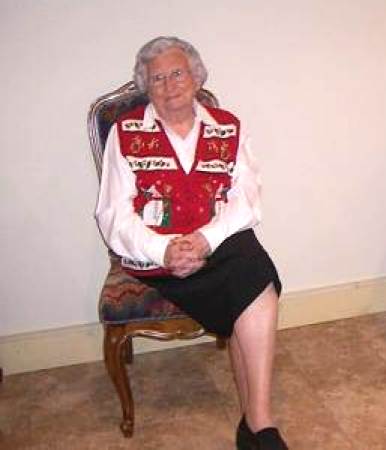
01 Elva Boyd Steen
You may remember I featured her recently on this website regarding the quilt she is quilting for us at the museum every Monday which she will donate to the museum as our next raffle quilt. In fact, this last week she had a helper, Doris Edwards Wyrick (photo 02).
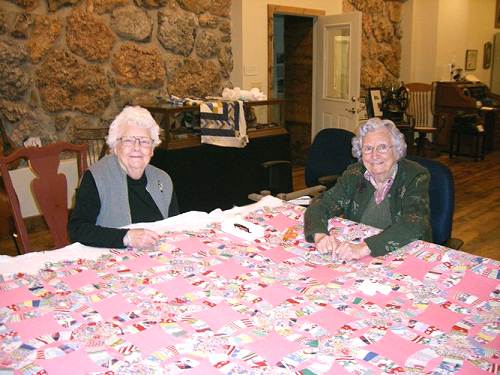
02 Doris Edwards Wyrick and Elva Boyd Steen
I am very grateful to live close to Elva because she gives me a lot of historical information about the Ulman area where she spent the early part of her life. What really helps is that Elva has kept a diary and, in addition, has written quite a few essays about her memories and experiences. One essay in particular she wrote seems very apt for receiving some attention these days because it describes how when she was a child she and her family lived during the Great Depression years ago.
Those of us who were born after those depression days which Elva experienced might benefit by learning how people got by with nothing more than the produce they could extract from the earth and the few farm animals they might have had for meat, milk, eggs and pulling the plow. Elva’s experiences as a young girl prepared her for her life on the farm, especially when her husband, Holmes, passed away twenty five years ago at which time she was prepared to manage and run by herself the large poultry and beef farm they owned.
I found this essay of Elva’s in an old box stored in one of Elva’s back closets which was full of old photos, diary entries and other memorabilia. It was handwritten on school tablet paper and the yellowish tint of the paper indicated it was several years old. Some of you might find it of interest. I know I did. Who knows? I and my wife might someday have to go back to the farm to live with Elva if Washington doesn’t get its act together! It wouldn’t be that bad since she makes the best cobblers and cinnamon rolls I ever ate!
My Early Life
Elva Boyd Steen
I was born in my grandparents’ home in 1924. I was the third child and the third girl. My dad had wanted a boy each time, and I can only guess how unhappy he was about me. We were so poor we had to live with my grandparents against my mother’s wishes. Finally, a two room house was built on the farm for us. We probably had a cow or two, a horse, some chickens…I think my mom had a wood stove, table and chair, and a cabinet. We had a bed and a few things for the second room.
My mom was from a big family…with her mother dying when she was 12. She thought she would have everything when she married my father since he was the only child. But my mother seemed to have to take the lead in all the work and all the planning. When I was small, 3 or 4, they rented a farm with a big house where I lived most of my unmarried life. We had a spring from where we carried buckets of water for use at the house. It was a long way to carry it. We also kept jars of milk, cream and butter in this spring through the warm months. My mom would wash clothes on a board down at the spring, building a fire under a big iron kettle, carrying clothes to the spring. There she washed off and on all day hanging clothes on the farm fence. I would play around the spring and the hill sides while my mom scrubbed on the wash board. She used home made soap made from fat meat and grease and lye. We had unfinished board floors. I remember my mom using left over wash water and scrubbing those floors.
My mother made all our clothes. She had no patterns. She cut them out by guess…but I had pretty dresses.
She took grown up size coats, ripped them up, sometimes turning them to the other side and made me coats. I also did this for my own little girls, for play coats.
I always walked a long ways to school, more than 2 miles. Girls never wore jeans or slacks. We had long cotton stockings. Sometimes my legs would get so cold above my knees where the wind whipped around my coat. My mom would patch the heels of my socks. When I needed garters to hold up my socks, I’d go to Granny’s house from school and stay all night. She’d make me some garters out of a car inner tube. If they were tight enough to hold up your stockings they would leave a red mark around your leg and if they weren’t that tight, your stockings would wrinkle and work down your leg.
What did we take to lunch? Biscuits with eggs, ham and sausage or bacon from meat we butchered. Sugar cookies, fruit mom canned and put in small jars, eggs, boiled or fried on a biscuit. It must have been hard for my mother to fix something for us. But I didn’t think about it then. One time a friend had graham crackers with powdered sugar between them. I wished my mom worked out as her mother did where I could have such treats. We probably also took jars of milk to drink.
What do I fix today for my grandchildren? One lived with me one summer. Canned pop, best of store bought meat, store bought bread, fresh fruit, chocolate chip cookies, candy bars and what ever. We never had extras in my folks’ house like crackers or snacks. I remember one night I came home from school and mom was out working on the farm as she always did. I was so hungry I ate a raw sweet potato.
My mom always worked with my dad at whatever he was doing on the farm… Pitching hay, building fence, or cutting wood. I helped my dad saw wood with a cross cut saw. A log laid across saw horses. I’d never admit I was tired after we carried the wood to the house and put it on the porch to burn in our wood stove. Now I use gas and turn the thermostat on. After I had been married for a long time we used a wood furnace where we threw wood down the outside basement steps leading to the door which opened to the furnace room. But we had to go out side and down to the basement each time we put wood in the furnace… maybe four or five times a day.
I think of how times have changed for bath taking. One strange thing to me is how people take baths or showers of a morning because for farm people to take a bath before going out to the barn or fields for a days work was unheard of. We took baths before we went to bed and that meant sponge baths or in a wash tub. My folks would take baths after dark out side in a wash tub and I guess I did too. Now people wash their hair every morning. I don’t remember how often we did; I don’t think it was very often. We never had heard of tooth paste or shampoo. We used soda or salt to clean teeth and soap for shampoo.
I can remember soaking my feet in a wash pan in winter because they were so chapped and dirty. My mother bought only what she had to. When wages were from $.50 to $1.00 a day you had no money to spend on what you didn’t have to have. It seems like we were always out of something. We used sacks that our flour came in for towels and wash clothes or sometimes rags. I know my grandmother always had a big rag to dry our feet on when we washed them of a night on the porch.
Can you imagine a young mother walking 2 miles or 3 miles to the farmers exchange store carrying chickens in each hand, 2 or 3 each? I remember carrying some, probably one in each hand. My mom also carried big buckets of cream that she had separated on the cream separator. We took eggs to sell for cash. For what groceries we had to have, she had the extra eggs which she would use for trade; we never went shopping. We only went to trade. If we could find extra eggs in the chicken house we could buy 3 or 5 cents worth of candy. They had this big candy case in which you could see what kind of candy they had. We knew which of the people who worked in the store would give you the most candy for your eggs. My mom would only buy the necessities …sugar, flour, coffee, and oatmeal. On the farm we had milk cream butter, eggs, and chickens to eat. Hogs were butchered in the fall. So we had lard and all kind of good cured meat. It seemed every farm had fruit trees and fruit that everybody canned. If someone had more than needed it was shared with neighbors. Most people had cellars where they kept canned stuff…some had big dug outs in the ground deep enough not to freeze, lined with straw. They could keep apples, cabbage, turnips and other perishables from the garden. My mom told me her dad would make a big jar of krout that would last most of the winter. We pickled berries, made jelly. I’ve wondered about us never having fresh vegetables or fruits through the winter but it surely didn’t hurt my folks as they lived long lives. I can see my mom standing over a wood stove canning and making jelly with sweat running off her face. Now women have to have air conditioned houses, with electric stoves, and if it’s too hot to cook just think about coming in the house after a days work in the field and have to build a fire in the wood stove to bake bread for dinner when it’s 100 degrees.
I’ve eaten corn bread and milk lots of times. Some people ate mush for the night meal. My mom made sugar cookies from fresh butter, no fancy cookies with chocolate chips or even brown sugar. I also loved to go to my grandmother’s and eat lumps of brown sugar or brown sugar mixed with butter. My mom made cakes and pies but not every day, just for special occasions. Other good things were baked apples, fresh peas and potatoes with gravy on them made with cream and butter, along with fried rabbit. She could fry cured ham better than anybody. My grandmother baked the very best biscuits you could imagine made with sour cream. They melted in your mouth and I would eat them until I was ashamed to eat any more.
I think of our weddings today, beautiful ones of my grandchildren where they paid 100 dollars to rent a Tuxedo and up to 1000 dollars for the dress and 2000 dollars for the wedding dinner and the wedding party. They think they have to have all this. When I got married I ordered a dress from a catalog where I didn’t have any choice of style for $1.49. It looked a little old for me but I made it over and it was pretty. I didn’t ask my mother to do it; I did it myself. The top was light blue and the skirt was navy. I had nice white heel shoes. We went to the courthouse and were married. We bought candy and tobacco for a chew to enjoy that night at my husband’s parents’ home and then early the next morning my husband and I were on our way to St. Louis to his job at a dairy. He had to milk 20 cows early that morning so we left before dawn. Another man rode with us back to St. Louis in our one seated car with a rumble seat. My husband made about 62 dollars a month. We stayed there less than a year because then my husband had to go to work in an army camp because the war had started.
After the war, the economy improved somewhat and more and more conveniences arrived so that life wasn’t so hard. But memories from the past of how we used to live still influence me so that I cannot bring myself to buy all the extras people do today. It seems so wasteful and I know that times could get hard again.
Thanks Elva. Here is a recent photo of Elva on the farm (photo 03).
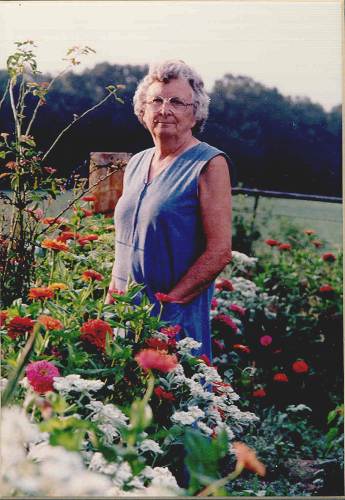
03 Elva on the Farm
Elva’s grandchildren are preparing a celebration of her upcoming 85th birthday. One of the most interesting aspects of the event is a compilation of old photos of Elva and her family from years past. One of the photos I happened to see from the collection shows that hard work was expected of everyone on rural Miller County farms back in the 1940’s. At least, that’s what the following photo suggests (photo 03a).
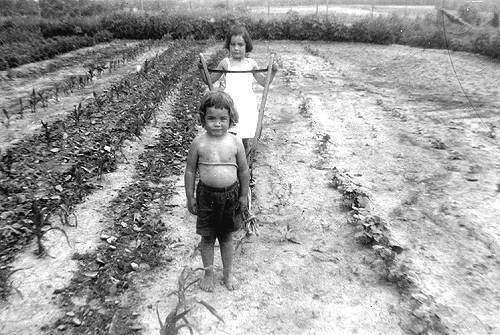
03a Plowing the Garden
That’s my wife, Judy, working the plow and her sister, Janie, pulling it.
(Actually, I think the kids were just playing. But they sure seem awfully serious don’t they?)
Last week I featured Peggy Hake’s history of the Iberia Academy. As you may remember, the Academy was brought to Iberia by a wonderfully gifted scholar named G. Byron Smith who by a number of extraordinary coincidences happened to arrive in Iberia late in the 19th century. Professor Smith had received his education at Knox College in Galesburg, Illinois. Probably because of Dr. Smith, another bright fellow from Knox College named Gerard Schultz came to Miller County to teach at the Academy sometime in the 1920’s. As some of you might know, Professor Schultz is the one who wrote the book, History of Miller County, published in 1933, which, along with the works of Clyde Lee Jenkins, has been one of the most complete references available about our county’s history. As a very interesting coincidence I learned recently that one of our own Miller County natives who went to the Iberia Academy left here afterward to go to Knox College himself. His story is very interesting I think so I will present it here:
The first time I heard of Mal Wickham (photo 04) was a few weeks ago when Patsy Adcock Wickham was telling me a story which occurred about twenty five years ago about a man who came into her father’s (Garland Adcock) store located just south of the Osage River bridge and asked directions to the old “poor folks farm.”
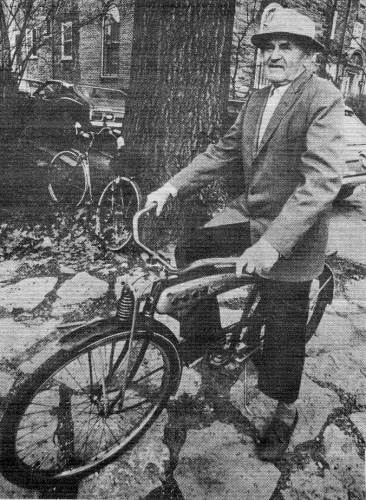
04 Mal Wickham
He wasn’t talking about the farm where the present Miller County Nursing and Rehabilitation Center now is located, but about the original “poor farm” which was located off Highway 52 on down toward St. Elizabeth (I discussed the “poor farm” in the Progress Notes of January 26). The man said he had his father in the car and that his father wanted to “sleep under the light of the moon” on the farm where he was born. Patsy, who was married to Harold Wickham, son of Ray Wickham, knew where the farm was located and gave directions. But the man seemed confused so she got in her car and followed them until they came to the correct turnoff. Then, out of curiosity, she inquired further and found that the man in the car was her husband Harold Wickham’s uncle Malachi Wickham, brother to Harold’s father, Ray Wickham. Many will remember that Ray Wickham owned the large farm on the west side of Highway 17 just north of the Miller County Nursing and Rehabilitation Center (known then as the Miller County Nursing Home). Ervin Snodgrass bought the farm from Ray and it still remains under the ownership of the Snodgrass family. Patsy says that she hadn’t known Uncle Mal, as he had left Miller County many years before, and hardly anyone remembered him. So, she left the car and its occupants and presumed that a quiet, peaceful night was spent by the folks since they weren’t seen again by her or any of the neighbors.
I thought some about this story over the last several weeks and began to become curious about this fellow, Malachi Wickham (known as Mal by everyone who had known him), who had left his home county and never returned until his last years of life for a final visit. To begin with, I found only a few people who remembered him. My 92 year old Uncle David Bear was one of those who remembered Mal but never knew what had happened to him. Further investigation revealed that Malachi Wickham was one of those unusually gifted people who come along once in awhile who truly can be called an “intellectual.” Mal’s one objective in life was to read the world’s “Great Literature,” and this quest lead him across the United States studying at Knox College in Illinois, Oberlin in Ohio, Harvard in Massachusetts and even Oxford in London. He ended his life farming in Janesville, Wisconsin but on the side continued taking literature courses at the nearby University of Wisconsin. But let’s let Malachi tell his own story. Patsy found the following article written by Mal published back in 1975 in the official school paper of the University of Wisconsin, “The Cardinal,” which she loaned to me to copy for you to read:
Portrait of the Philosopher as a Young Rascal
By Mal Wickham
Special to the Cardinal
University of Wisconsin
June 16, 1975
I was born in 1884 in a log home…two rooms and a loft where the children slept. Later, we moved to a better farm and a new frame home when I was four years old. I can remember when we moved as well as after and we moved; for example I remember the wheat field and mother’s rice, how good it tasted. We had no telephone, cars, electricity, tractors, or newspaper.
We seldom got farther than two miles from home in a wagon pulled with two horses; we had never heard of a university or college. Had no books and had never heard of a library. Our heads were not quite as empty as the animals around us but not too much difference, I imagine.
Some of the children had to walk two miles to school; the teacher I don’t think had ever had the opportunity to get much education. He never had heard of Columbus, believe it or not, and apparently had never seen a history book. About the only thing we ever heard about was “Hell” and it was sure a hot place and never did cool off even in the wintertime, according to him. Later we boys discussed this Hell subject when our parents were away from home and one boy said hell is 20 times as hot as our cook stove…as he looked at the red hot stove in our room. We hoped we would never land in that place!
When I finished country school at age 21, I had never heard of a verb or the word, “grammar.” But some one said the name of our town was a noun.
So at the age of 21, I walked 20 miles to Iberia Academy carrying a suitcase, but not many clothes in it. Cora, our older sister, felt she wanted to go so we boys did same as she. Sometimes I wonder if women haven’t more all around sense that men anyhow. Our mother was a better human than dad was, I think.
I was glad Professor Smith, who was the Director of the Academy at Iberia and taught there as well, had been graduated from Knox College. He didn’t examine my head when I arrived or he might have refused admittance. I do not know why he came to this benighted community but I suppose the good Lord said to him,” Here’s the place to go in ’96.’
Both Greek and Latin were taught at Iberia Academy and I started to study Latin and Grammar at the same time. To my surprise I was best student in Latin and made 100 on examinations. One day I wrote out the exam and handed it to the teacher who gave me a “100.” I had some time left and noticed a girl was having some trouble with the exam. I wrote another paper and handed it to her and she made a ‘100’ too! Now, of course, that wasn’t an appropriate thing to do but I didn’t know that then. But the “Buggar Man” didn’t get me.
Soon I was reading Cicero and Virgil and some of those empty regions in my head were being filled with new ideas and I sure loved all those new ideas. Neither my mother nor my dad knew anything about such things.
After spending four years at the Iberia Academy I was graduated. Then I went to Knox College when I was 25 years old. At Knox in addition to my studies I spent much time in the library reading Emerson, Walt Whitman, Wordsworth, Shelley, Carlyle, and others. Such geniuses awakened in me creative tendencies, a desire to know more…to read more books besides my books in college: maybe I was becoming a fanatic or extremist because even Friday and Saturday nights I spent at the library reading books that I loved and books that no one told me to read. I began selling aluminum ware in Oshkosh, Wisconsin during summers and I soon discovered that I was a pretty good salesman. So I soon had plenty of money and I began to want my own books to read.
After a while, I had collected 150 of my own books. One day a professor came to my room and said, “Do you understand such books?” I said I do and I love them. He said, “Are you a genius?” I said, “No, but I surely do love geniuses,” and I think I know them when I read a few lines in their books. Emerson soon became my Bible! I enjoyed him much more than the Bible. He led the way to Goethe, Wordsworth, Plato, Aristotle, Kant, Hegel, Fichte, Schopenhauer, Jung, Freud, and Shakespeare. After I finished at Harvard and six months in England, I wanted to buy a farm so I could continue to study the above great minds. Well, I sold groceries for ten years for John Sexton and made enough money to buy a farm and lovely new home at Janesville, Wisconsin.
One thing I lacked…a non conformist girl and at the Wisconsin Summer School I found her. It just took me two minutes to tell her so and she said later, “I knew before two minutes were up it was going to happen.” I can honestly say that farm girl was more than I ever dreamed she was. When she was 15, she was reading great poets and loved them. She would quote beautiful lines of poetry to our two daughters and they would say, “Mother, where did you get that?” She would say, “Got it out of fifth grade reader before I went to high school.”
I soon was reading James, Dewey, and Bergson. Bergson in his “Creative Evolution” said “For a conscious being to exist is to change. To change is to mature. To mature is to go on creating oneself endlessly…thus our personality shoots, grows and ripens without ceasing. Each of its moments is something new added to what it was before.” When I began to get ideas like these I thought “Give me more ideas like these so that such a boy as I was when I was 19 or 20 may ripen up some just like the corn ripens up.” I hardly knew yet that such ideas would soon transport me beyond the ghost, hellfire and buggy man kind of life!
Bergson said, “Our life is spent in filling voids”…and there still were many empty places in my head! Emerson, Bergson, and Dewey awakened new forces operating in my mind. My wife was reading a lot of our new books…as we now owned some 500. The seeds out in the fields were not the only ones sprouting. As Bergson says the élan vital, the vital force in all healthy young minds is a ceaseless up springing of something new. Neither of us used drugs to weaken this vital force that lifts life out of weak repetition and decadent, nihilistic chaos into a creative advance into reason and meaning we hardly had dreamed of.
Robert Ingersoll said “We need no myths, no miracles, no devils and to hell with hell.” Also he said “Reason, observation and science are the Holy Trinity! Fear paralyzes the brain! Progress is born of courage; courage stands erect and thinks. Fear believes in witchcraft, in devils, in ghost, what men need is science and freedom for each man to think for himself.”
I have also always loved Phil Whitehead. He seemed to possess much of both reason and feeling as is expressed in his “Adventures of Ideas.” He speaks highly of Plato’s seven factors: Ideas, Physical Elements, the Psyche, the Eros, the Mathematical Relations, the Receptacle, the Harmony. The more perfect the interweaving of these factors the more pronounced the Harmony. Shakespeare says that the movement of all planets radiates a harmony like music if we could only hear it. The musicians seem to be aware of it. Whitehead says, “The human body is a delicate instrument for the production of art in the life of the human soul.” Whitehead says “A race preserves its vigor as long as it harbors a real contrast between what has been and what may be; and so long as it is nerved by the vigor to adventure beyond the safeties of the past.” Today, the world is passing into a new stage of its existence. Eros motivated by adventure creates a synthesis of the old and the new, giving birth to novel feelings and ideas in the self…a sort of creation of self by the self. An open mind accompanied by wide purpose seems to generate emotions bordering on deep harmony and peace of mind.” The static, noncreative mind always looking to the past is a sort of dumping ground…a pessimist…. a leaning on old myths, the customary conventional drives… I am not sure whether drugs would come in this category or not.
I have been trying for 20 years to figure out what Whitehead is saying in the last 15 pages of “Adventure of Ideas” and am curious yet as to all it means. “Truth, beauty, adventure, art, peace!?” I chose the term Peace for the harmony of harmonies, which calms destructive turbulence and completes civilization. It enlarges the field of attention. It increases the present by transforming the past and by anticipating the future. It is unreasonable for a person who has kept company with a large number of the minds of geniuses to feel that body decay ends the domain of a growing personality and this points toward impersonal realities in nature.
My wife loved poetry, flowers and art and great music and the interaction of these creative essences are an ample introduction to aesthetics itself. Dewey in his book, “Art as Experience,” says “To the being fully alive the future is not ominous but a promise; only when the past ceases to trouble and anticipation of the future is not perturbing is a being wholly united with his environment and thereby wholly alive.” Instead of signifying being shut up within one’s own private feelings and sensations, it signifies active and overt commerce with the world. In life that is truly life everything overlaps and merges. We are, as it were, introduced into a world beyond this world which is nevertheless the deeper reality of the world in which we live in our ordinary experiences. We are carried out beyond ourselves to find ourselves. How beautifully in Lord Byron’s poem, “Childe Harold’s Pilgrimage,” each verse goes with the one above. “There is a pleasure in the pathless woods. There is rapture on the lonely shore. There is society where none intrudes, by the deep sea, and music in its roar. I love not man the less, but nature more, from these our interviews, in which I steal from all I may be, or have been before, to mingle with the universe and feel what I can ne’er express, yet cannot all conceal.”
Shelley in his prose essay, “A Defense of Poetry,” (1821) we have read many times parts of the fifteen pages it encompasses. The second and third parts were never written. Too bad!
Perhaps nature and human life contain in those deeper recesses some hidden tendency to be in tune. Shelley says in his “Defense….,”
“Poetry is ever accompanied with pleasure: all spirits on which it falls open themselves lo receive the wisdom which is mingled with its delight. It is impossible to feel with these great poets and not become a portion with them; sacred emotion can render men more amiable, more generous and wise, and lift them out of the dull vapors of the little world of self. Poetry turns all things to loveliness, it exalts the beauty of that which is beautiful, and it adds beauty to that which is most deformed. It marries exultation and horror, grief and pleasure, eternity and change…the mind is its own place, and of itself can make a heaven of hell, a hell of heaven…it makes us the inhabitants of a world to which the familiar world is a chaos.”
The Greeks were the first people who began asking questions and discussing what nature means. Thales was the first man to predict an eclipse 586 B.C. Many thought the world was coming to an end. (“Some of them kind left around today!”) Thales said, “Quiet down, sun will soon shine again.”
The Greeks had more courage and began to reason. One of them said, “Listen to the sad story of mankind, who like children lived until I gave them understanding and a portion of reason.”
Plato’s “Idea,” which was based on reality, was new to man and later gave birth to chemistry, sciences, and psychology. Many more men today know something about reason as technology has produced so many inventions just in my lifetime. Who knows what will happen in the next 60 years? In another 100 years reason and reflection will become common among men and will eliminate war and race prejudice as well as evoke more good will as we move into a much higher evolved civilization.
I have found 95% of the students in Wisconsin University are open minded and ready to discuss such problems. It has been a delight to me to talk to them and reason with them. I now know some 2000 students here and there are no dumb heads around here, and if there are a few they will soon outgrow it.
These universities are doing a job no one else can do. I am a farmer and know what the agriculture schools should have done for farmers the last 75 years. We couldn’t grow alfalfa…no lime on the land; agriculture school said put lime on the land! And thereafter we had no more trouble growing alfalfa.
Schopenhauer in his great book, “World and Idea,” says, “To act rationally and to act virtuously, nobly, holily, would be one and the same thing, and to act selfishly, wickedly, viciously, would be to act irrationally.” Schopenhauer was Nietzsche’s great teacher. Nietzsche says, “The present age is weakness of will! With the philosopher it is strength and courage of will…exercising the power in the will…be a man, not a weakling…a nothing! Only will propelled by ideas is the difference between a man and an animal.”
Whitehead’s five or six books have meant much in my education. He says, “Adventure is what saves civilization from staleness, boredom, and orthodoxy.”
It is unreasonable for a person who has kept company with a large number of the minds of genius to feel that body decay ends the domain of the growing personality. Maybe it is an entering into the values of nature, which knows no boundaries. If nature is rational and is propelled by ideas as man becomes more rational and familiar with ideas, just in this degree is he in harmony with nature, creative Eros urging towards perfection.
Thanks Mal.
Well, I must say I feel really illiterate when I contemplate all the great books Mal read and all the quotes from the great authors he remembered! It is really an amazing wonder that someone from the deprived rural life so common in Miller County in the late 19th century could have had the motivation to seek such a profound lifelong learning experience as did Malachi Wickham from Tuscumbia, Missouri. I’m suspicious he may have been an agnostic which would be a philosophy different than mine but no doubt he was a person of unusual interests and abilities. I would have loved to have met him!
I looked up Mal’s family history and found he is one of the original Miller County Wickhams’ being a grandson of Halsey Wickham, the first Miller County Wickham to come here from back East. Jobe Wickham, son of Halsey, was the father of Mal as well as his siblings Cora, Milton, Effie, Ralph, Rex, and Raymond. Apparently, the family lived for a short while near the old “Poor Folks Farm” off Highway 52 going east toward St. Elizabeth, but moved to the farm known locally as the Wickham farm on Highway 17 when Mal was a young boy.
I found another reference to Mal located in a Knox College (Galesburg, Illinois) bulletin in which Mal is recognized by his fellow alumni from the first college he attended:
Knox College Alumni Association
Galesburg, Illinois
1974
An Alumnus Profile
He’s Still Learning
At 90 years of age, Malachi Wickham, ’09, is enrolled in courses in philosophy, anthropology, psychology, and comparative literature at the University of Wisconsin (photo 05 which accompanied this article).
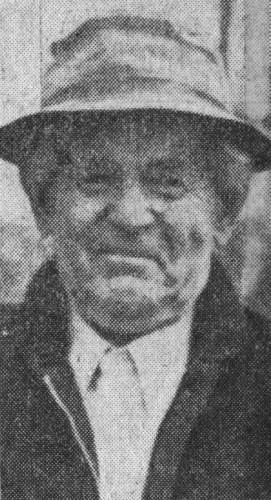
05 Mal Wickham
Wickham was born in Missouri in 1884, spent some time selling groceries and farmed for 40 years in Janesville, Wisconsin. After receiving the B.A. degree from Knox, he attended Harvard for a year and continued from there throughout the years at Oberlin and at the University of Wisconsin.
“I studied and did the things I thought I ought to do to get the most out of life,” he said in an interview with the university’s “Daily Cardinal,” and added that he’s still studying because, “you’re building into your life something that is real.”
Mal Wickham returned to school this year with a desire to get to know and talk to “intellectual youngsters” and an insatiable drive for knowledge. His main interests are philosophy, psychology, and poetry.
“You want to know how I got to be 90 years old?” Wickham asked the Cardinal reporter, “It’s because I understand the chemistry of food. You need a variety, just like life.”
It’s important, according to Wickham, to be strong in mind and body. “Don’t be a weakling,” he advised, “Don’t pattern yourself after anyone.”
“If people could live out their own lives they would be optimists.”
I looked in the phone directory for Janesville, Wisconsin and found only one Wickham listed. I called the number and had a nice visit with an eighty year old gentleman who remembered Mal and the farm on which Mal lived. However, the gentleman said that his own ancestors had come to Wisconsin directly from the East without a detour to Missouri so he and Mal were not related through recent generations of Wickhams although, certainly, they had common ancestors from long ago in New York where both his as well as Mal’s Wickham ancestors originated. Nancy Thompson, our museum director and genealogist discovered that the social security death index shows Mal (who was born 19 April 1884) died in April 1980 in St. Paul, Minnesota. She also found a short obituary about him (photo 06).
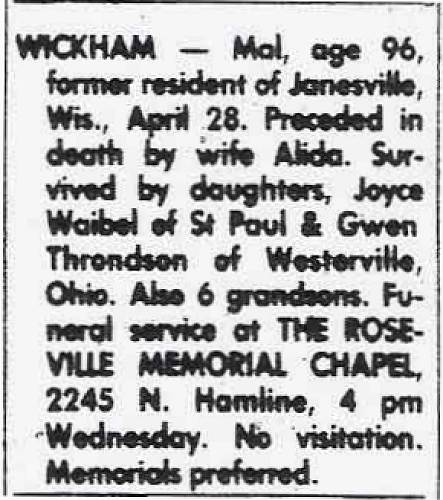
06 Mal Wickham Obituary
I tried to locate some of the relatives listed in the obituary but no phone numbers were listed in any of the resources to which I referenced. I haven’t followed up with any Miller County relatives except for Patsy whose husband Harold was a nephew of Mal. But as Patsy says, when Mal left Miller County most everyone had little contact with him although word did get back once in a while that he was a “really well educated relative who taught and associated with very smart people up there at the University of Wisconsin.”
I was about to give up on finding any living members of Mal’s immediate family but, fortunately, once again David Statler, who arranges this web page for us, located one of Mal’s daughters, Gwen Throndson, who lives in Westerville, Ohio. I called Gwen and we had a very nice conversation about her father, Mal. She confirmed all the above including the trip he made to Miller County with Gwen’s nephew, Gil Weibel, just a few years before his death for the purpose of “sleeping under the stars” on his birthplace farm. Gwen said that yes, indeed, Mal had travelled the world to study great literature including Heidelberg University in Germany. Gwen said that Mal had been a successful farmer and had the means to send his two daughters, Gwen and her sister Joyce, to college. She also confirmed that Mal was a revered and respected personality on the campus of the University of Wisconsin even when he was past ninety years old. She said the students loved to have him as a guest in their classes to participate in discussions about the world’s greatest writers and thinkers. So, I am delighted to have presented this story about one of our own Miller County natives who, after attending Iberia Academy, left the area to become not only a successful farmer but also a recognized popular figure of the literary arts on one of our nation’s great university campuses, the University of Wisconsin.
Last week our county seat got some national attention with the news that our Osage River bridge replacement project was the first in the nation to receive funds from the national stimulus package. The story was well covered in the Autogram by Ginnie Duffield:
Miller County Autogram Sentinel
Stimulated
Tuscumbia bridge is believed to be first started in nation minutes after federal stimulus package signed
By Ginny Duffield
A $8.5 million contract with APAC-Kansas City was signed Tuesday afternoon, Feb. 17, alongside the old Osage River bridge, for its replacement. The Missouri Highway Commission, meeting
with three commissioners on the river bank and three others attending via telephone, approved the contract within minutes of President Barack Obama signing the federal economic stimulus package at a ceremony in Denver. Shortly after that, Gov. Jay Nixon sounded a horn and work started on the new bridge, making the project the first in the nation to be funded by the federal bill.
The project received national media attention. Completion of the project is slated for September 2010. The bridge carries traffic for Highways 17 and 52 across the river. The new bridge will be 970 feet long and 28 feet wide, with a pair of 11-foot driving lanes and three-foot shoulders. The bluff on the south end of the project area will have to be taken down to accommodate a new approach. The design is similar to the bridges crossing the Osage just below Bagnell Dam.
The old bridge is only 20 feet wide but is slightly longer, at 1,084 feet. Because it is on the National Historic Register, MoDOT will have to offer it for preservation or for sale. Sometimes sections of old bridges are purchased for smaller stream crossings. If it is not sold or given away, the bridge eventually will be demolished. A buried telephone cable in the area has already been moved by
AT&T. Rock from the bluff will be used to build up the approach on the Tuscumbia side of the new bridge but the grades of the approaches and the bridge will be similar to the old bridge.
A public hearing on the project was held in Tuscumbia in April 2007. In September 2007, a special inspection was made of the old bridge because it is of similar design to one that collapsed in Minnesota. Large trucks were kept off the bridge for a time but after some repairs were made the bridge reopened to normal traffic. Bids for three other projects also were approved at the special highway commission meeting. They are for work in Clinton County, Pemiscot and New Madrid counties and Barry, Lawrence, Christian and Green counties. The four projects total $51.1 million and the bids, opened Jan. 20 and contingent on Missouri receiving stimulus money, came in more than 21 percent under project estimates. “We’re going to be able to put people to work on this in the next two or three weeks,” Gov. Jay Nixon said about the Tuscumbia project.
Once the contract was signed, a check for more than $212,000 was handed by MoDOT Director Peter Rahn to APAC-Kansas City President Guillaume said suppliers of materials would get orders immediately. It is estimated that the bridge project will involve 250 jobs, although some will be elsewhere in the state with suppliers. Rahn said the four projects approved Tuesday will employ about 1,450 people. “Once again, Missouri is leading the way,” Nixon said. He noted that in 1956, the first project on the nation’s interstate highway system was started in O’Fallon. “You can see the condition of it, with rebar sticking out,” Rahn said, pointing to the underside of the old bridge, which was completed in 1933. The new bridge will be eight feet wider than the old one. Commission member Mike Kehoe, who chaired the meeting, said the new bridge is “sorely needed.” “We are anxious to deliver this project to the residents of Miller County,” Rahn said.
Nixon said he is anxious to get Missourians back to work, noting 219,000 are unemployed and 10,000 jobs have been lost in the last year in Missouri. Rahn said there were two reasons the Osage River bridge was chosen to be among the stimulus projects MoDOT will do. The first was all of the work on the design was done and right-of-way had already been acquired. The other was it was a needed project that would not be funded any other way. Economists complained that departments of transportation in the various states could not use federal stimulus money fast enough to do any good, Nixon said. MoDOT has proved them wrong. “It’s nice to be first. It’s nice to lead the country,” Nixon said. “Come Friday, they (the workers at the site) are going to have a paycheck.”
Others attending the ceremony included all three Miller County commissioners, Tom Wright, Darrell Bunch and Brian Duncan; Sheriff Bill Abbott, and Rep. Rodney Schad of the 115th District.
MoDOT set up a communications trailer at the site over the weekend, providing cell phone service as there is no signal available in that area, and also streaming video from the ceremony to any news organization that wanted to use it.
In addition, I am copying here from the February 18 edition of the Jefferson City Tribune four photos which that paper published for this event (photos 06c and 06f). Thanks to David Statler, our website director for Progress Notes for alerting me to this article:

06c Crumbling Bridge
Photo credit: Bob Watson / News Tribune

06f Current Bridge
Photo credit: Bob Watson / News Tribune
Also, you might take a look at our website’s history of the opening ceremony for the old bridge back in 1933 at this URL:
http://www.millercountymuseum.org/events/bridgededication.html
Before signing off I thought I would let you take a nostalgic audio visual excursion on this audio visual file sent me by Sam Webster of Eldon (audio visual file photo 07).
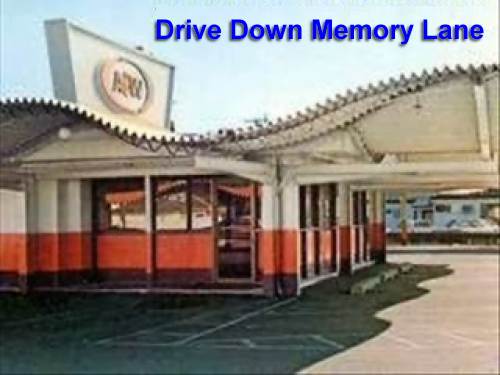
07 Drive Down Memory Lane Video (WMV Format)
Click image above to watch video
That's all for this week.
|



